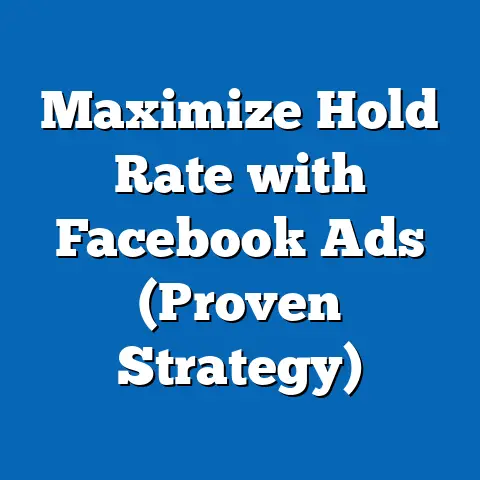Unlocking fb ad Set History (Insights for Better Ads)
Digital advertising has become the lifeblood of modern businesses. I’ve seen firsthand how companies, both large and small, are pouring significant portions of their budgets into platforms like Facebook, aiming to connect with their target audiences, drive sales, and build brand awareness. But simply throwing money at Facebook ads isn’t a recipe for success. It requires a strategic approach, and that’s where understanding your Facebook Ad Set History becomes absolutely crucial.
Think of it this way: you wouldn’t drive a car blindfolded, would you? Similarly, you shouldn’t run Facebook ads without understanding what has worked and what hasn’t in the past. Your Ad Set History is your rearview mirror, offering a wealth of insights that can guide your future campaigns and prevent you from repeating costly mistakes.
In this article, I’m going to delve deep into the world of Facebook Ad Set History. I’ll explain what it is, why it’s so important, and how you can use it to unlock valuable insights that will transform your advertising strategy. My goal is to equip you with the knowledge and tools you need to make data-driven decisions, optimize your ad spend, and ultimately achieve a higher return on investment.
We’ll explore key metrics, analyze trends and patterns, and learn how to translate those insights into actionable strategies for your future campaigns. Get ready to ditch the guesswork and start making informed decisions based on real data. Let’s unlock the power of your Facebook Ad Set History together!
Understanding Facebook Ad Sets
Before we dive into the historical data, let’s make sure we’re all on the same page about what an ad set actually is. In the Facebook advertising ecosystem, the ad set is a fundamental building block, sitting between the overarching campaign and the individual ads themselves.
Think of it as a container that holds all the settings and parameters for a specific group of ads. Each campaign can contain multiple ad sets, each targeting a different audience or using a different strategy.
To illustrate, imagine you’re launching a campaign to promote a new line of athletic shoes. You might create separate ad sets to target different segments of your audience:
- Ad Set 1: Fitness Enthusiasts: Targeting users interested in running, weightlifting, and other fitness activities.
- Ad Set 2: College Students: Targeting students at local universities, perhaps with a student discount offer.
- Ad Set 3: Previous Customers: Retargeting users who have previously purchased from your online store.
Each of these ad sets would have its own unique targeting criteria, budget, schedule, and ad placements. This allows you to tailor your message and approach to each specific audience, maximizing the effectiveness of your advertising efforts.
The Structure of a Facebook Advertising Campaign
To further clarify the role of ad sets, let’s take a look at the overall structure of a Facebook advertising campaign:
- Campaign: The highest level of organization, defining the overall objective of your advertising efforts (e.g., website traffic, lead generation, sales).
- Ad Set: The middle level, defining the specific audience, budget, schedule, placements, and bidding strategy for a group of ads.
- Ad: The individual creative elements that users see, including the headline, text, image or video, and call to action.
This hierarchical structure allows for granular control and optimization. You can test different audiences, budgets, and ad creatives within a single campaign, and then use the data to refine your strategy and improve your results.
Key Components of an Ad Set
Understanding the key components of an ad set is essential for interpreting its historical performance data. These components include:
- Audience Targeting: Defining the specific demographics, interests, behaviors, and connections of the users you want to reach. This is where you specify things like age, gender, location, interests, and custom audiences based on your existing customer data.
- Budget: Setting the daily or lifetime budget for the ad set. This determines how much you’re willing to spend to reach your target audience.
- Schedule: Defining the start and end dates for the ad set. You can also specify the days and times you want your ads to run.
- Placements: Choosing where your ads will appear on Facebook, Instagram, Audience Network, and Messenger. You can opt for automatic placements or manually select specific placements based on your preferences.
- Bidding Strategies: Selecting the bidding strategy that aligns with your campaign objectives. This determines how Facebook will bid on ad placements on your behalf. Options include cost per click (CPC), cost per impression (CPM), and cost per acquisition (CPA).
The Importance of Historical Performance Data
Now that we’ve established the basics of ad sets, let’s talk about why historical performance data is so important. Simply put, it’s the key to unlocking better results. By analyzing the data from your past ad sets, you can gain valuable insights into:
- What works: Which audiences are most responsive to your ads? Which ad creatives generate the highest click-through rates? Which placements deliver the best conversion rates?
- What doesn’t work: Which audiences are unresponsive? Which ad creatives are ineffective? Which placements are a waste of money?
- Trends and patterns: Are there seasonal fluctuations in performance? Are there specific days or times when your ads perform better? Are there emerging trends in audience behavior?
By understanding these factors, you can make more informed decisions about your future campaigns, optimize your ad spend, and improve your overall ROI.
Takeaway: Ad sets are the building blocks of your Facebook advertising strategy. Understanding their components and the importance of historical performance data is the first step towards unlocking better results.
The Importance of Ad Set History
Ad Set History is, in essence, a digital time capsule of your advertising efforts on Facebook. It’s a record of everything that’s happened within your ad sets, from the initial launch to the final day of running. It’s a treasure trove of data waiting to be mined for insights that can transform your campaigns.
I’ve found that many advertisers, especially those new to the platform, overlook this powerful tool. They focus on the immediate results of their current campaigns, without taking the time to analyze the past. This is a missed opportunity, because your Ad Set History holds the key to understanding your audience, optimizing your ad spend, and achieving your business goals.
What is Ad Set History?
Ad Set History is a feature within the Facebook Ads Manager that allows you to view the performance of your past ad sets. It provides a detailed breakdown of key metrics, such as impressions, clicks, conversions, and cost per result. You can filter the data by date range, ad set, and metric, allowing you to drill down and identify specific trends and patterns.
Think of it as a comprehensive report card for your ad sets. It shows you how well each ad set performed, highlighting its strengths and weaknesses. This information is invaluable for making informed decisions about your future campaigns.
How Ad Set History Functions
Ad Set History works by continuously tracking and recording the performance of your ad sets. Every time someone sees your ad, clicks on it, or converts on your website, that data is recorded and stored in your Ad Set History.
This data is then aggregated and presented in a user-friendly interface within the Facebook Ads Manager. You can access your Ad Set History by navigating to the “Ads Manager” section of your Facebook Business account and selecting the “Reports” tab.
From there, you can customize your report by selecting the date range, ad sets, and metrics you want to analyze. You can also download the data in a CSV file for further analysis in a spreadsheet program.
Benefits of Accessing Historical Data
The benefits of accessing historical data are numerous and far-reaching. Here are some of the most significant advantages:
- Identifying Trends: By analyzing your Ad Set History, you can identify trends in your audience behavior, ad performance, and overall campaign effectiveness. This allows you to anticipate future changes and adjust your strategy accordingly.
- Understanding Audience Behavior: Your Ad Set History provides valuable insights into how your target audience interacts with your ads. You can see which demographics are most responsive, which interests resonate most strongly, and which ad creatives generate the highest engagement.
- Optimizing Ad Spend: By understanding which ad sets are performing well and which are underperforming, you can optimize your ad spend and allocate your budget more effectively. This ensures that you’re getting the most bang for your buck.
- Campaign Refinement: Your Ad Set History provides a roadmap for refining your campaigns and improving your results. By identifying areas for improvement, you can make data-driven changes that lead to higher conversion rates and increased ROI.
- Improved ROI: Ultimately, the goal of analyzing your Ad Set History is to improve your return on investment. By making informed decisions based on data, you can optimize your campaigns and achieve better results with the same budget.
Real-World Examples
To illustrate the power of Ad Set History, let’s look at a few real-world examples:
- E-commerce Store: An e-commerce store selling handmade jewelry analyzed their Ad Set History and discovered that their ads targeting women aged 25-34 were performing significantly better than their ads targeting women aged 35-44. They adjusted their targeting to focus on the younger demographic, resulting in a 20% increase in sales.
- Local Restaurant: A local restaurant analyzed their Ad Set History and discovered that their ads promoting lunch specials were performing better on weekdays than on weekends. They adjusted their schedule to focus on weekdays, resulting in a 15% increase in lunchtime traffic.
- Software Company: A software company analyzed their Ad Set History and discovered that their ads featuring video testimonials were generating higher conversion rates than their ads featuring static images. They shifted their focus to video ads, resulting in a 25% increase in lead generation.
These examples demonstrate the transformative power of Ad Set History. By taking the time to analyze your data, you can uncover valuable insights that can lead to significant improvements in your advertising performance.
Takeaway: Ad Set History is a powerful tool that provides valuable insights into your past advertising efforts. By accessing and analyzing this data, you can identify trends, understand audience behavior, optimize your ad spend, and improve your overall ROI.
Key Metrics Found in Ad Set History
Now that we understand the importance of Ad Set History, let’s dive into the specific metrics you’ll find within it. These metrics provide a detailed picture of your ad set’s performance, allowing you to identify areas for improvement and make data-driven decisions.
I’ve found that many advertisers get overwhelmed by the sheer number of metrics available in Facebook Ads Manager. It’s important to focus on the metrics that are most relevant to your campaign objectives and to understand how they relate to each other.
Here’s a breakdown of the essential metrics you’ll find in Ad Set History:
- Impressions: The number of times your ads were displayed to users. This metric indicates the reach of your campaign and the overall exposure of your brand. A high number of impressions suggests that your ads are being seen by a large audience, but it doesn’t necessarily mean that they’re engaging with them.
- Click-Through Rate (CTR): The percentage of users who clicked on your ads after seeing them. This metric measures the effectiveness of your ad creative and targeting. A high CTR indicates that your ads are relevant and engaging to your target audience.
- Calculation: (Number of Clicks / Number of Impressions) x 100
- Interpretation: A higher CTR generally indicates a more compelling ad and relevant targeting. Industry benchmarks vary, but a CTR above 1% is often considered good.
- Cost Per Click (CPC): The average cost you paid for each click on your ads. This metric measures the efficiency of your ad spend. A low CPC indicates that you’re getting a good value for your money.
- Calculation: Total Ad Spend / Number of Clicks
- Interpretation: Lower CPCs mean you’re acquiring clicks more efficiently. Monitor CPC in relation to conversion rates to gauge overall ROI.
- Conversion Rate: The percentage of users who completed a desired action (e.g., purchase, lead submission) after clicking on your ads. This metric measures the effectiveness of your landing page and the overall user experience. A high conversion rate indicates that your landing page is relevant and persuasive.
- Calculation: (Number of Conversions / Number of Clicks) x 100
- Interpretation: A higher conversion rate means your ads are effectively driving desired actions. Optimize landing pages to improve this metric.
- Return on Ad Spend (ROAS): The amount of revenue you generated for every dollar you spent on advertising. This metric measures the overall profitability of your campaign. A high ROAS indicates that your campaign is generating a significant return on investment.
- Calculation: Revenue Generated from Ads / Total Ad Spend
- Interpretation: ROAS directly reflects profitability. A ROAS above 1 is generating more revenue than ad spend.
- Audience Demographics and Engagement Metrics: These metrics provide insights into the demographics, interests, and behaviors of the users who are engaging with your ads. You can see which age groups, genders, and locations are most responsive to your ads. You can also see which interests and behaviors are most strongly correlated with conversions.
- Calculation: (Number of Clicks / Number of Impressions) x 100
- Interpretation: A higher CTR generally indicates a more compelling ad and relevant targeting. Industry benchmarks vary, but a CTR above 1% is often considered good.
- Calculation: Total Ad Spend / Number of Clicks
- Interpretation: Lower CPCs mean you’re acquiring clicks more efficiently. Monitor CPC in relation to conversion rates to gauge overall ROI.
- Calculation: (Number of Conversions / Number of Clicks) x 100
- Interpretation: A higher conversion rate means your ads are effectively driving desired actions. Optimize landing pages to improve this metric.
- Calculation: Revenue Generated from Ads / Total Ad Spend
- Interpretation: ROAS directly reflects profitability. A ROAS above 1 is generating more revenue than ad spend.
How Each Metric Influences Future Strategies
Each of these metrics can influence your future advertising strategies and decision-making processes in different ways:
- Impressions: If your impressions are low, you may need to increase your budget or expand your targeting to reach a larger audience.
- CTR: If your CTR is low, you may need to improve your ad creative or refine your targeting to make your ads more relevant to your target audience.
- CPC: If your CPC is high, you may need to optimize your bidding strategy or improve your ad quality to lower your costs.
- Conversion Rate: If your conversion rate is low, you may need to improve your landing page or streamline your conversion process to make it easier for users to complete the desired action.
- ROAS: If your ROAS is low, you may need to re-evaluate your entire campaign strategy and identify areas for improvement.
- Audience Demographics and Engagement Metrics: These metrics can help you refine your targeting and tailor your message to specific segments of your audience.
Case Studies and Hypothetical Scenarios
To further illustrate the impact of these metrics on campaign performance, let’s look at a couple of case studies and hypothetical scenarios:
- Case Study: Low CTR: A company running Facebook ads to promote a new product noticed that their CTR was significantly lower than the industry average. They analyzed their ad creative and discovered that their headline was not compelling enough. They rewrote the headline to focus on the benefits of the product, resulting in a 50% increase in CTR.
- Hypothetical Scenario: High CPC: A company running Facebook ads to generate leads noticed that their CPC was very high. They analyzed their bidding strategy and discovered that they were bidding too aggressively. They switched to a cost-per-result bidding strategy, resulting in a 30% decrease in CPC.
These examples demonstrate the importance of monitoring your key metrics and making data-driven adjustments to your strategy. By paying attention to the numbers, you can identify areas for improvement and optimize your campaigns for better results.
Takeaway: Understanding the key metrics in Ad Set History is essential for optimizing your Facebook advertising campaigns. By monitoring these metrics and making data-driven adjustments, you can improve your ad performance and achieve your business goals.
Analyzing Trends and Patterns
Now that we’ve covered the key metrics in Ad Set History, let’s talk about how to analyze that data for trends and patterns. This is where the real magic happens. By identifying trends and patterns in your historical data, you can gain valuable insights into your audience behavior, ad performance, and overall campaign effectiveness.
I’ve found that many advertisers struggle with this step. They have the data, but they don’t know how to interpret it. They get lost in the numbers and fail to see the bigger picture.
Analyzing Data Over Different Periods
One of the most important things you can do is to analyze your data over different periods of time. This allows you to see how your performance changes over time and identify any seasonal fluctuations or emerging trends.
For example, you might analyze your data on a daily, weekly, or monthly basis. You might also compare your performance year-over-year to see how your business is growing.
Here are some questions to ask yourself when analyzing your data over different periods:
- Are there any days of the week when my ads perform better?
- Are there any months of the year when my sales are higher?
- Are there any emerging trends in my audience behavior?
The Importance of Seasonality and Market Changes
Seasonality and market changes can have a significant impact on your ad performance. It’s important to be aware of these factors and to adjust your strategy accordingly.
For example, if you’re running ads for a holiday-themed product, you’ll likely see a spike in sales during the holiday season. Similarly, if there’s a major market change (e.g., a new competitor entering the market), you may need to adjust your pricing or messaging to remain competitive.
Visualizing Data Trends
One of the best ways to analyze data trends is to visualize them using graphs and charts. Facebook Ads Manager provides a variety of built-in charting tools that you can use to visualize your data.
For example, you can create a line chart to track your impressions over time. You can also create a bar chart to compare the performance of different ad sets.
Visualizing your data can help you identify trends and patterns that you might otherwise miss. It can also make it easier to communicate your findings to others.
Segmenting Data for Deeper Analysis
Another important technique is to segment your data for deeper analysis. This involves breaking down your data into smaller, more manageable groups based on specific criteria.
For example, you might segment your data by audience type, ad creative, or geographic location. This allows you to see how different segments of your audience are responding to your ads.
By segmenting your data, you can uncover valuable insights that can help you refine your targeting and messaging.
Takeaway: Analyzing trends and patterns in your Ad Set History is essential for understanding your audience behavior, ad performance, and overall campaign effectiveness. By analyzing data over different periods, considering seasonality and market changes, visualizing data trends, and segmenting data for deeper analysis, you can unlock valuable insights that can help you improve your advertising results.
Implementing Insights into Future Campaigns
Now that you’ve analyzed your Ad Set History and identified valuable insights, it’s time to put those insights into action. This is where you translate your findings into actionable strategies for your future campaigns.
I’ve seen many advertisers who are great at analyzing data but struggle with this step. They have the insights, but they don’t know how to implement them. They get stuck in analysis paralysis and fail to take action.
Translating Insights into Actionable Strategies
The first step is to translate your insights into actionable strategies. This involves identifying specific changes you can make to your targeting, budget allocation, and ad creative based on your historical performance.
For example, if you discovered that your ads targeting women aged 25-34 were performing significantly better than your ads targeting women aged 35-44, you might adjust your targeting to focus on the younger demographic.
Adjusting Targeting, Budget Allocation, and Ad Creative
Here are some specific ways you can adjust your targeting, budget allocation, and ad creative based on your historical performance:
- Targeting: Refine your targeting to focus on the demographics, interests, and behaviors that have proven to be most responsive to your ads.
- Budget Allocation: Allocate more of your budget to the ad sets that are performing well and less to the ad sets that are underperforming.
- Ad Creative: Test different ad creatives to see which ones generate the highest click-through rates and conversion rates.
Common Pitfalls to Avoid
When implementing insights into future campaigns, it’s important to avoid these common pitfalls:
- Overreacting to short-term fluctuations: Don’t make drastic changes to your strategy based on short-term fluctuations in performance. Look for long-term trends and patterns before making any major decisions.
- Ignoring external factors: Remember that external factors (e.g., seasonality, market changes) can also impact your ad performance. Don’t attribute all changes in performance to your own actions.
- Failing to test and iterate: Advertising is an iterative process. Don’t be afraid to test different strategies and to make adjustments based on the results.
The Iterative Nature of Ad Optimization
Ad optimization is not a one-time event. It’s an ongoing process of testing, analyzing, and refining your strategy. You should continuously monitor your performance, identify areas for improvement, and make adjustments based on the results.
By embracing the iterative nature of ad optimization, you can continuously improve your results and achieve your business goals.
Takeaway: Translating insights from Ad Set History into actionable strategies is essential for improving your Facebook advertising campaigns. By adjusting your targeting, budget allocation, and ad creative based on your historical performance, you can optimize your campaigns and achieve better results.
Conclusion
In conclusion, I want to reiterate the immense value that Facebook Ad Set History holds for any business investing in digital advertising. It’s not just a collection of past data; it’s a roadmap to future success. By understanding what an ad set is, recognizing the importance of historical data, analyzing key metrics, and implementing insights into future campaigns, you can unlock the full potential of your Facebook advertising efforts.
Remember, the world of digital advertising is constantly evolving. What worked yesterday may not work today. That’s why it’s so important to stay informed, to continuously learn, and to embrace a data-driven approach to decision-making.
By regularly utilizing Facebook Ad Set History, you can unlock insights that will lead to better ad performance, increased return on investment, and ultimately, the achievement of your business goals. So, dive into your data, explore the trends and patterns, and let your past performance guide your future success. The transformative power of data-driven decision-making is within your reach. Embrace it, and watch your advertising efforts soar.






